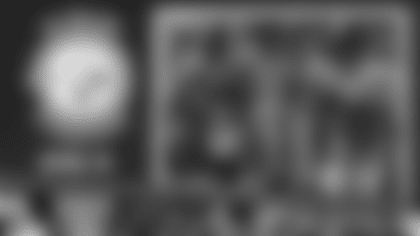Q. Generally speaking, what do you believe needs to be accomplished during the pre-preseason game portion of a training camp?
A. I think you have to present certain elements of ball to them, so that when they go into a stadium they show a certain element of preparedness. You just can't spot a ball in a training camp setting and play. You have to work on elements of situational football. You've got to talk about rule changes and points of emphasis. You've got to develop them in so many things other than the physical traits of blocking and tackling and running and securing of the ball or the pursuit of the ball.
There are many nuances that go on during the course of play, elements of the game where understanding is a big part of the evaluation. And that understanding has to be on display. That's why we do the many things we do, particularly during that second week (of camp) in terms of introducing elements of situational football into the preparation. It's all geared toward getting them ready for stadium play. That's why we fought the battle we fought last Sunday in terms of making sure we got that short-yardage and goal-line work done in the midst of that inclement weather and lightning. Because no way will I take this group into a stadium ill-prepared in that area.
Q. Did you get that accomplished this summer?
A. I'm really comfortable with what this group has been able to do from that standpoint. We tackle more than most teams in a training camp setting in today's NFL. I embrace that element of our uniqueness, because I think that sets the stage for preparedness when they go into the stadium. Are the tackles going to make themselves? No, we have to make the tackles when we step in stadiums, we have to play with an edge. But I think how we work in Latrobe, producing elements of live football in each and every practice when we're wearing helmets and shoulder pads prepares them for that.
Q. Is there some standard or level of proficiency a player must attain before he gets to play in a preseason game?
A. I don't know if I look at it that way. If he's healthy, I'm interested in seeing what these guys can do in a stadium, but there's definitely a line to be met in terms of ascending out of that third group. I often tell these guys that in September in the National Football League there is no third team. So if you're on the third team in August, you better do what it takes to get off the third team. So you'll see a lot of guys getting third team reps, and everybody who's healthy and has been working is going to get an opportunity to play. In most instances, the question is: Who gets reps beyond that third group? Those have to be earned.
Q. If I'm a player trying to win a roster spot this summer, what kinds of things can I do tonight to make a positive impression on you?
A. Show awareness and production in special teams. If you're talking about a guy who's new to us and hasn't had a role on this team in the past and he's really trying to drop a stake in the ground and show he's serious about earning a spot, then it's production in teams. Covering a kickoff and making the tackle. Covering a punt and making the tackle. Showing awareness relative to the game in those areas. Staying away from breaking stupid rules, like running out of bounds and coming back in and touching the ball first. Not being penalized in special teams to force us to re-kick the ball. Those are JV-like things. You have to display varsity-like performance in special teams if you want to have a shot of dropping a stake in the ground as a result of this performance. Knowledge of rules, playing clean from a penalty standpoint, and showing an element of production will get that done.
Q. Would it be possible for me to cut myself tonight, or is it a situation where no sin I commit tonight cannot be forgiven by better play moving forward?
A. Never say never. I'm sure there's something that can be done that would get somebody cut tonight. Hopefully that isn't the case, but experience tells me it's not impossible.
Q. How have you handled the new leading-with-the-helmet rule in terms of teaching the players? Can something like that be taught in a classroom setting, or is it something that has to be repped physically for it to take?
A. You very much handle it in a classroom setting. The interesting thing about the helmet rule is: NOBODY teaches those (leading-with-the-helmet) plays that occur anyway. It's not an element of your teaching. It's not an element of your fundamental tackling. So it's not like from a drill standpoint, the drills need to change. We're just really utilizing a classroom setting in terms of making the point of emphasis that, yes, we realize that's not coached, that's not drilled, but it happens and it cannot because of this rules change. These are ways we can ensure it does not happen. Those are more the discussions than anything else. There's not a drastic change in terms of our coaching or our presentation of drill work. The drills have been within that rule for years, for as long as I've been in the National Football League.
Q. Speaking of new rules, what do you expect from the new kickoff rules?
A. There is an element of unknown regarding this new kickoff rule and the changes, because the changes are so many. There are so many elements to the changes, and so I think it leads to more questions as to how these plays are going to play out. So it makes you take a real fundamental approach to the play in the early stages of this thing from a preseason game standpoint. From a kickoff return standpoint, the most fundamental thing for us is to gain possession of the football. We cannot have a ball on the ground. That's where our focus is. There are only three guys in the back portion of the return area, and those three guys have a lot more ground to cover than they used to. So the fielding of the ball is paramount. It's going to be interesting how that plays out in preseason stadiums in terms of kickers spraying the ball around.
From a kick coverage standpoint, I want to see our guys run down (under the kickoff) with speed. The contour of the return units are very different. That different structure creates unfamiliarity in terms of a blocking structure. All of that usually slows people down. The groups that maintain speed and can run down the field, the individuals who can navigate those unfamiliar waters while still running down with speed, I think have a chance to excel. So those are the areas of focus for us.
Q. Who are those three guys going to be who will be charged with fielding the ball for the kickoff return unit?
A. I think we're all discovering that. Who those guys are, and what those guys look like. Part of that new rule was to get some of those bigger people off that unit, because those bigger people create some of those collisions back there. Expect a smaller guy. You used to see defensive linemen back there. Chris Hoke was a Steelers player who was back there for a number of years in that structure. You won't see guys like Hoke back there anymore. There is too much ground to cover. There are too many potential balls to field. That's an element of change, and we'll just have to see how it goes. I think we all have the same mentality, and by "all" I mean all of us globally have some unknown regarding it.
Q. Might you be inclined to instruct Chris Boswell to keep the ball in play to learn some things about the new rule and learn some things about what it might take to be successful both returning kickoffs and covering kickoffs?
A. I always have that mentality in the preseason. Very rarely do we kick touchbacks in the preseason. But I think we're in the minority in that regard. I have too many guys I have to evaluate in kickoff coverage. If you went back and looked at our kickoffs last year, the year before, even the year before that, you could back to 2007, you'd see us putting a lot of balls in play because we have to find out who can cover a kick and make a tackle.
Q. What has No. 1 pick Terrell Edmunds showed you so far in this camp?
A. His pedigree has been evident, as it should be. I think that's why you draft someone in Round 1. His movement has not been disappointing in any way, both in a straight line and laterally. He's a sharp young man. He's a quick study. We kind of knew that about him; that's what made him attractive. The rest we'll discover as we continue to roll the ball out. He likes the competition. I think that's been evident, and it aids in the evaluation process and the developmental process. We'll keep rolling forward.















